'No summit too high' for amputee climbers
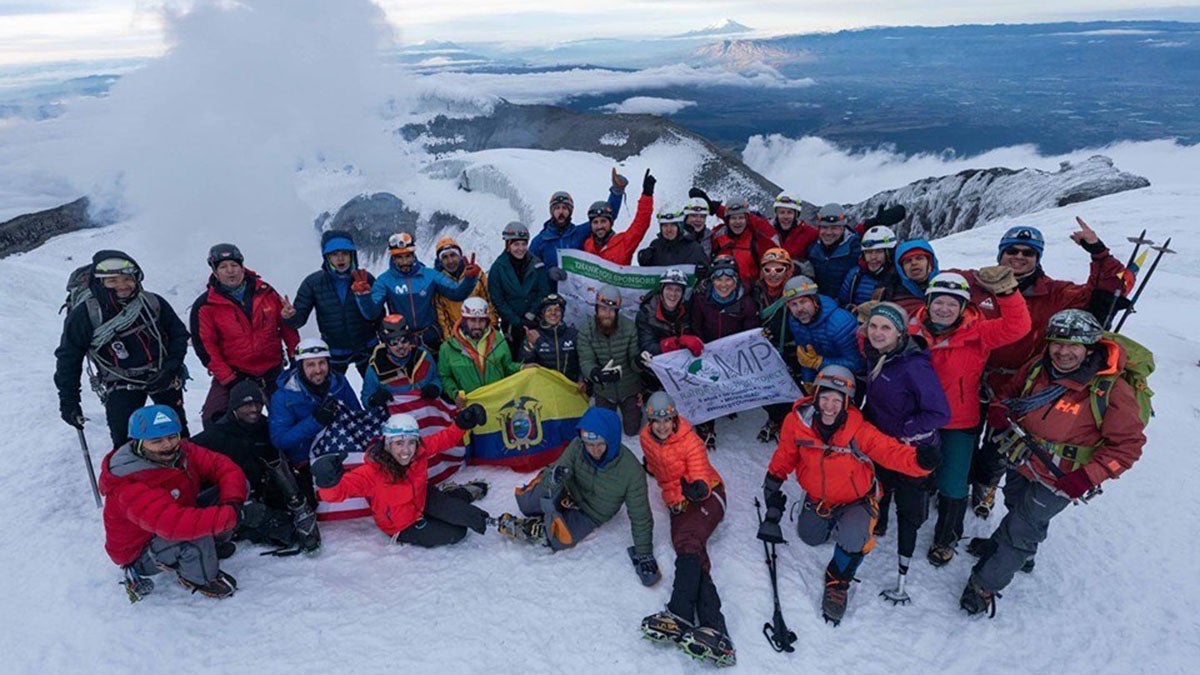
Seven amputees who found themselves atop a 19,347-foot volcano in Ecuador last month probably never envisioned themselves there together.
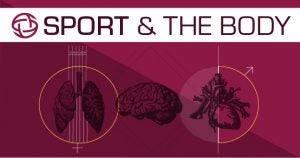
But with the proper prosthetic limbs and training for the climb, the group reached the summit of Cotopaxi, one of the world’s highest volcanoes, as part of a team of 26 climbers with the nonprofit Range of Motion Project (ROMP).
“We are trying to show the world what is possible when you have access to the right prosthetic technology,” said Lauren Panasewicz, ROMP’s director of development. “When you have access to the right tools, the right team and the right mindset, no summit is too high.”
The amputees on the team included Kirstie Ennis, a U.S. Marine Corps veteran who lost her leg in Afghanistan and became a Paralympic snowboarder; cyclist Meg Fisher, who totalled four medals at the 2012 and 2016 Paralympics, including two time-trial gold medals in London, and Sandy Dukat, a three-time medalist in Paralympics skiing in the 2002 and 2006 games who also set world records for above-the-knee amputees in the marathon and triathlon.
The elite athletes have different stories behind becoming amputees, athletes and climbers. But everyone in the group climbed Cotopaxi with the common goals of fundraising for and increasing awareness of amputees who lack the prosthetic care they need. The team raised more than $100,000 – enough to provide prosthetic limbs for 100 amputees in Latin America and the U.S.
To the group of amputees, volunteers and ROMP staff who committed to months of training and raising funds, the summit was not just a personal achievement. They came together for the purpose of improving care for amputees and demonstrating what amputees can do.
“The elite athletes of the world — what they do is an amazing display of the human body and what it’s capable of,” Ennis said. “But I think, especially for us adaptive climbers and especially people like me who are adaptive adventure athletes, it’s truly a display of the human spirit.”
The problem ROMP is up against is daunting, but the solution is simple.
“Eighty percent of amputees live in the developing world. Less than 5 percent of them have access to prosthetic care,” Panasewicz said.
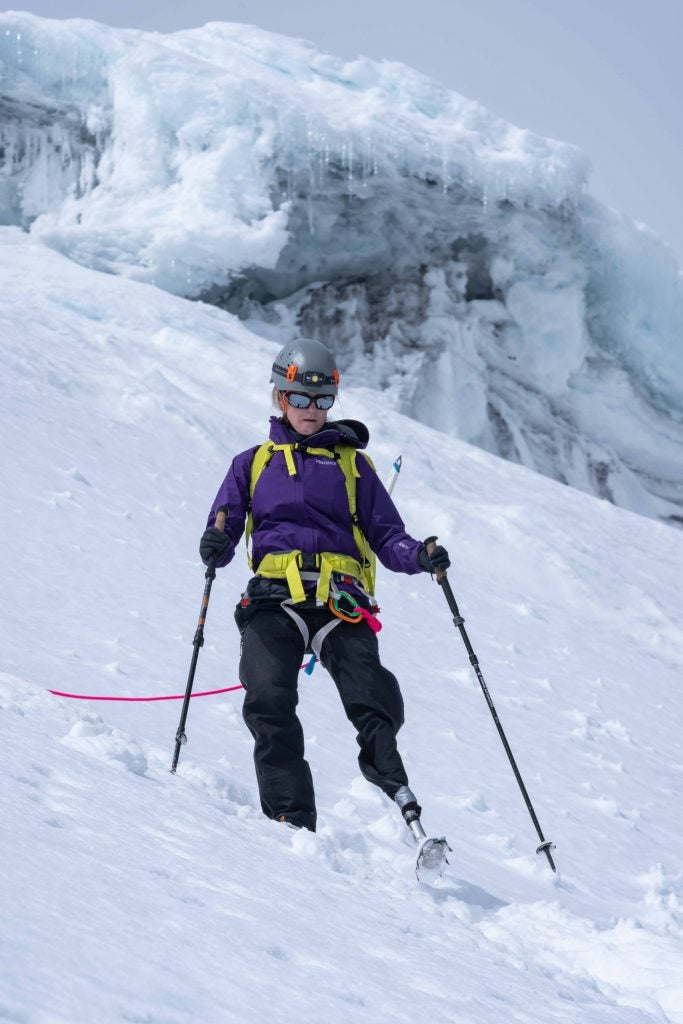
Because health care is lacking in developing countries, a minor injury can cause infection that goes unchecked, or diabetes can go untreated. The result is often an amputation. And many areas have no prosthetic clinics, so amputees have no way of getting a prosthesis even if they can afford one.
“The solution is building partnerships with already existing clinics and offering affordable care for people,” Panasewicz said.
ROMP has a stand-alone clinic in Guatemala, where people can get evaluated for their first prostheses, have an existing one serviced or get new liners or prosthetic adjustments. ROMP purchases new components, refurbishes donated prosthetics and invents new devices to meet the needs of patients.
ROMP has also partnered with other foundations and operated a mobile clinic in Mexico and Honduras.
“The solution is more trained professionals, and more funding to get the right technology to where it needs to be,” Panasewicz said.
ROMP asks patients to invest in their own care at a highly discounted rate, to cover a portion of the device’s cost, which helps keep the program sustainable, Panasewicz said. But when someone can’t pay, the organization finds a way to cover it. ROMP also helps amputees in the U.S. who face financial hardship or lack insurance.
Amputees in the U.S. have “very real complaints about accessibility and structural and emotional barriers, and the prejudice that comes with it,” Dukat said. But in some developing countries, accessibility is not just difficult; it is nonexistent.
“It is hard to feel acknowledged living with a disability in a developing country,” she said.
“I constantly feel like I’m in a state of defense with my disability – and proving my true abilities, and what is possible and what I can do,” Dukat said, adding that in some countries she “wouldn’t even have the opportunity to defend myself, because it’s not even seen as something worth listening to. That is a very blunt contrast, but that’s what we’re dealing with.”
The clinics and tools amputees need are easy to find in the U.S., but they are expensive and often difficult to get.
“People have this misconception that somebody can just go out and get a leg,” Ennis said. “Well, no two legs are the same. Everything is custom. To be able to be efficient on your limb, you have to go to a good prosthetist.”
Ennis lost her leg in a helicopter crash in Afghanistan, and she said she is thankful that she lost her leg through military service rather than cancer, for example, because her military health insurance offers better coverage than private health insurers do. Amputees with private insurance often have a hard time getting what they need, she said.
And, beyond getting the appropriate prosthesis, “you have to take the time to educate yourself on how to use it, and unfortunately, insurance companies are not really taking time to make sure that their patients are trained on their limbs,” Ennis explained. “So even if they have the resources, they don’t know how to properly use them to actually get the most benefits from them.”
Dukat said that a clause in her health insurance policy at one point covered only one prosthesis for her entire lifetime – with no coverage for a replacement or repairs.
“My first prosthesis was made for me when I was 10 months old,” she said. “If that’s truly what I was restricted to, I would have blown my one use at 10 months and never remembered it.”
There also are restrictions on what sort of technology amputees in the U.S. can access. For instance, coverage might pay for a prosthetic leg suitable for walking, but not one designed for running or swimming. For those, athletes often must pay out of pocket, Panasewicz said. A walking leg can range from $5,000 to $50,000, depending on the level of amputation and complexity of the device, she said. A running leg can range from $15,000 to $25,000.
“We believe that every amputee should be able to access the prosthetic care that they need to live their best life,” she said. “So if you want to be a runner, you should be able to get a running leg. We believe it’s a human right.”
Mobility encompasses much more than the ability to walk or play sports.
“When your mobility is stripped away from you, it affects your entire life,” both physically and emotionally, Panasewicz said.
Dukat agreed.
“What it brings to someone’s livelihood is irreplaceable,” she said.
“It’s easy to look at a leg and say, ‘it’s just a leg,’ but it could give somebody the opportunity to take care of their family, or it can restrict somebody to living a very sheltered life and just living off Social Security,” Ennis said. “I’m a firm believer in what the power of mobility can do for somebody.”
The climb
To make that point, the amputees targeted the top of Cotopaxi. Their summit of the active volcano marked Climbing for ROMP’s fifth anniversary, which included 50 community climbs worldwide in 2019.
Dukat said she was struck by the collective energy of 26 people committed to the same mission.
“It was truly inspiring to watch the motivation and determination of every one of us that stepped up to the plate to raise the money, climb the mountain and then make sure that care is provided,” she said.
Several ROMP patients joined the elite team on one of its two training hikes leading up to Cotopaxi.
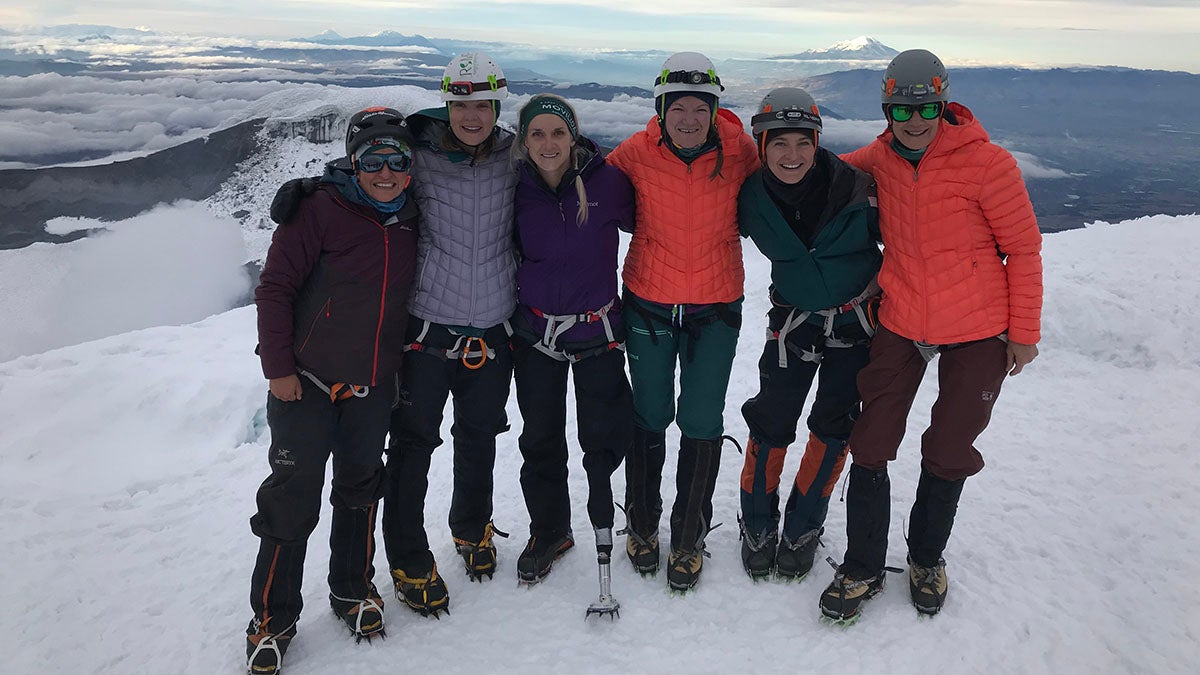
“It’s awesome that we were able to have a team of climbers at Rucu Pichincha who were ROMP patients,” Dukat said.
Panasewicz added, “They thanked us for being a part of getting more Ecuadorian amputees prosthetic care.”
Fisher climbed Cotopaxi with ROMP last year as well.
“Last year, I felt very physically capable, primarily because I had a well-fitting prosthesis,” she said. “And this year I’ve been needing to get a new socket, because my fit has changed.”
She wasn’t sure she would be able to complete the climb with the ill-fitting prosthesis. She managed, but said the climb was more difficult.
“Last year, I was able to climb quickly, and actually help other people who were struggling. This year, I was the one who was struggling. I was in quite a bit of pain,” she said.
The experience was humbling and served as “a reminder that I was lucky I could still climb that mountain. I still had the resources, and I still had people to help me, so I could do that. And so many people can’t,” Fisher added.
One climber from Mexico had the same prosthetic knee as Ennis, but she didn’t know how to use it well, especially going down stairs or on inclines or declines. So Ennis helped show her.
“We did a bunch of different exercises to help her learn how to use it the right way,” for her day-to-day use, “and then we got her on other terrain to help maneuver a little more efficiently,” Ennis said. “Once she picked it up, I started crying. I was like a proud mom. You could tell that it actually clicked, and it was great.”
The healing power of sports
Ennis said that sports saved her life.
“Mountaineering has been in my life for only a few years,” she said. “But snowboarding is what got me out of the hospital and got me, along with my support system, back to being who I really was. It gave me that confidence that I can go out and do anything.”
Still, there was more to endure. Ennis’s last amputation was in 2016, after she already had emerged as an elite snowboarder. But that led her down a new path.
“Snowboarding was too much of an impact, and I lost the 2016-17 snowboarding season to the surgery, and so I decided I was going to take to the mountains in a different way,” she said. “I decided I was going to climb the highest point in Africa, Mount Kilimanjaro, and it was really just an effort to keep me focused and give me a goal to train for – and keep my eyes up, if you will.”
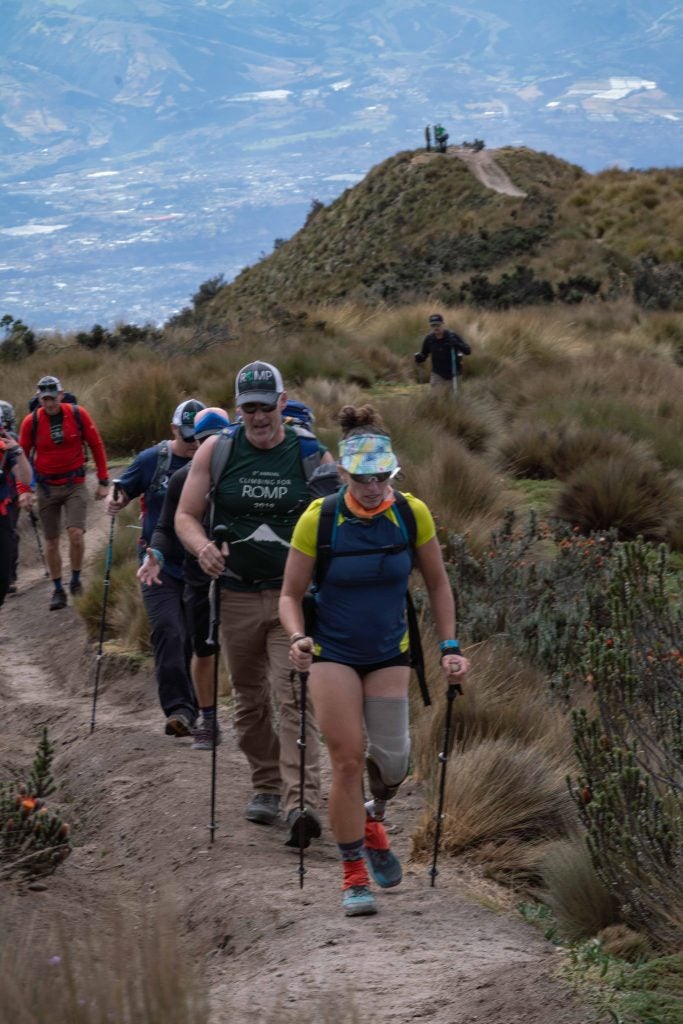
The Kilimanjaro climb was a success, and Ennis raised money for clean water for east Tanzanians. Next, she established a team of women veterans to climb Denali, the 20,310-foot peak in Alaska, and now she has set out to become the first female above-the-knee amputee to climb the seven summits – the highest peak on each of the world’s seven continents. She was the first woman amputee to summit Aconcagua, the 22,837-foot monster in Argentina.
Ennis has established the Kirstie Ennis Foundation, which aims to improve quality of life for people and, she said, to “push the advancements in medical-device technology and spread the message of inclusion.”
“The outdoors is there for all of us,” she said. “Do I think that we should build ramps up to the top of Everest? Absolutely not. But I do think there are things that we can put in place to be able to make these things accessible and attainable so that people can heal in the outdoors.”
For her work, Ennis received the Pat Tillman Award for Service at the ESPYS in July. The award is named for the former Arizona State and Arizona Cardinals player, who gave up his football career to serve in the elite Army Rangers. He was killed in Afghanistan.
Dukat noted that sports offer a way to achieve incremental successes.
“We benefit from feedback in our lives,” she said. “You can see that you went further on your bike today than yesterday, or you are now making baskets from your wheelchair. You see results pretty quickly.”
Dukat is a Paralympic swimmer and skier who medaled three times in alpine skiing. When she decided to try running, she started by running 30 seconds on a treadmill, and then one lap around a track, “and I felt successful,” she said. “We all like successes in our lives.”
But, she pointed out, the goal doesn't have to be as lofty as climbing a mountain.
“Your summit is the goal you set for yourself,” which could be walking a block or getting back in the swimming pool.
“I think we heal through sports,” Dukat said. “There’s a reason why we introduce people who have been recently injured to adaptive sports – because it’s a way to regain identity, confidence, self-esteem, everything that gets wrapped up in that bubble.”
As her competitive career was waning, Dukat and four other para-alpine ski racers decided to climb Kilimanjaro to raise awareness of women athletes with physical impairments and to provide scholarships for them.
“It starts getting people to think differently about what’s possible among the disability community, and among themselves,” she said.
When ROMP founder Dave Krupa invited her to join ROMP for the 2015 Cotopaxi climb, Dukat said it was good timing.
“I was just enough years away from retirement from competitive sports,” she explained. “I was just starting to need a goal to work toward. I needed something to put myself into.”
Fisher also understands how sports can motivate. She is now a physical therapist. She played tennis in college and lost her leg following an automobile collision when she was 19. Eleven months after her amputation, she completed her first triathlon.
“Sports for me has been tremendously motivational,” Fisher said. “I was back on the tennis court even before I could walk. I was on an office chair with wheels before I had a prosthesis, scooting around teaching tennis.”
Panasewicz said people often take their mobility for granted until they lose it.
“I know a lot of people who are more athletic now after losing a limb,” she said. “It lights a fire to take advantage of your mobility with a healthy body.”
And she said people may have no idea what an amputee is capable of achieving until they see it.
“I’m an able-bodied female athlete, and Cotopaxi is the hardest thing I’ve ever done,” Panasewicz said. “So watching someone else do it on one leg is like, ‘damn, that is awesome.’ ”
The group that summited Cotopaxi shared the experience of climbing a mountain together, showing what they can do, and advocating for others who lack mobility. The climb is a testament to “the resilience of the human spirit and body,” Fisher said.
Allison Torres Burtka is a freelance writer and editor based in metro Detroit. You can read more of her work here.

